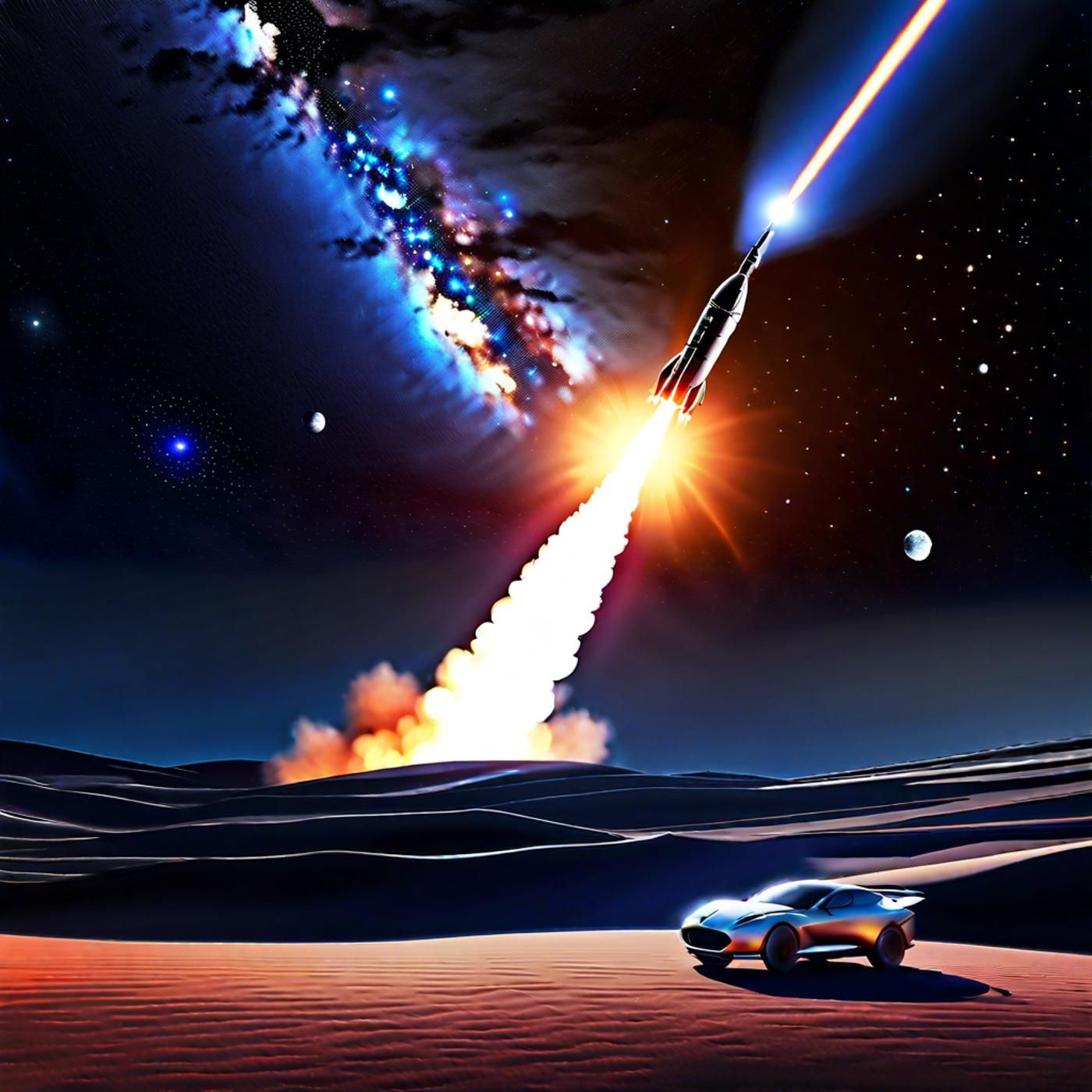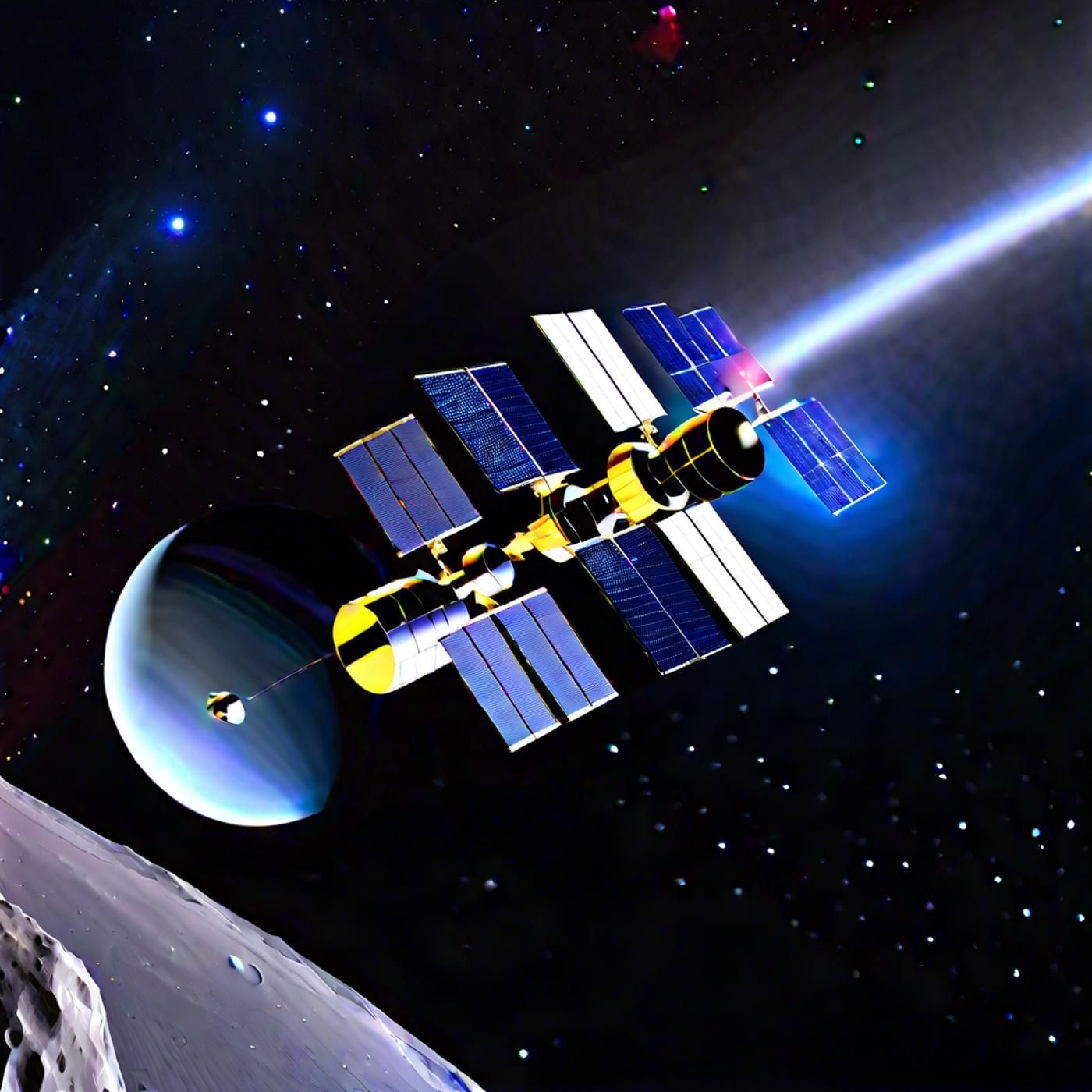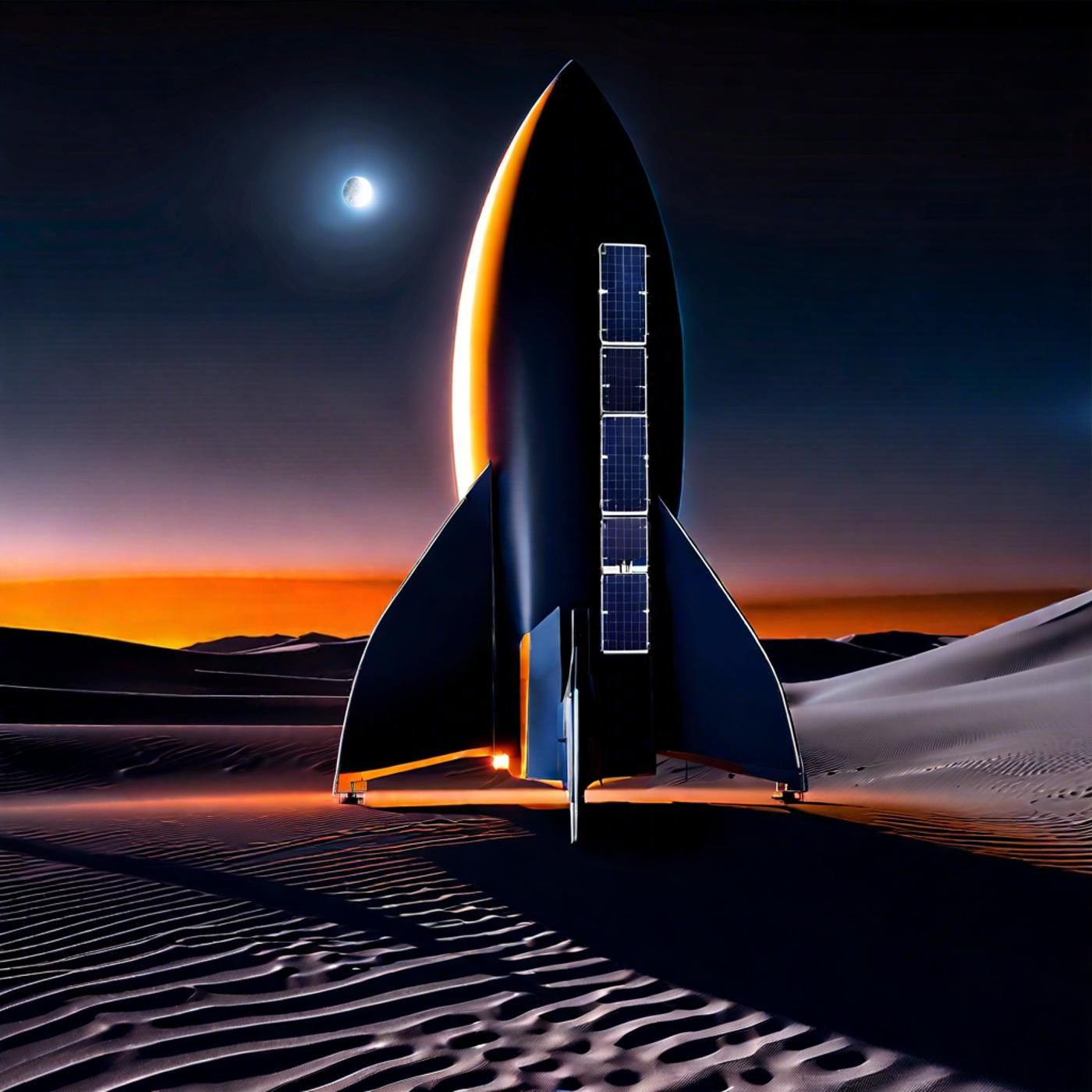S03E46: Solar Storms & Asteroid Encounters: The Dynamic Dance of Earth and Space

Venture through the cosmic gateway on today's episode of Astronomy Daily - The Podcast, where we pierce the veil of the night and delve into the mysteries of the universe. Host Anna guides us on a stellar journey from the auroral artistry painted by a...
Venture through the cosmic gateway on today's episode of Astronomy Daily - The Podcast, where we pierce the veil of the night and delve into the mysteries of the universe. Host Anna guides us on a stellar journey from the auroral artistry painted by a G4 geomagnetic storm to the anticipated close encounter with the asteroid Apophis. We'll explore the fiery outbursts of our galaxy's supermassive black hole through NASA's Chandra X-ray Observatory and tackle the environmental implications of SpaceX's Starship program. As we navigate the enigmatic rotation of galaxies, we'll weigh the evidence against alternative gravity theories and ponder the elusive nature of dark matter. Join us as we bridge the gap between the celestial and the terrestrial, seeking harmony in our quest for the stars.
1. **Auroral Symphony**: Experiencing the G4 geomagnetic storm's skyward spectacle.
2. **Apophis' Close Approach**: Preparing for a historic asteroid flyby in 2029.
3. **Galactic Chimneys**: Unveiling the Milky Way's supermassive black hole's influence.
4. **Starship's Earthly Impact**: SpaceX's environmental review by the FAA.
5. **The Dark Matter Debate**: Examining the latest challenges to alternative gravity theories.
For a deeper dive into the cosmos, visit our website at astronomydaily.io, and join our community on X (@AstroDailyPod) for ongoing discussions and updates.
Until our next cosmic rendezvous, this is Anna urging you to keep your eyes on the skies and your heart attuned to the universe's whispers. Clear skies and godspeed to all our fellow space explorers!
This episode is brought to you with thanks to NordPass...the password manager you need in your life. It's the one we use and swear by. Check out our great deal by visiting www.bitesz.com/nordpass - you'll be glad you did.
Become a supporter of this podcast: https://www.spreaker.com/podcast/astronomy-daily-the-podcast--5648921/support.
AI Transcript
Welcome to astronomy daily, the podcast where the secrets of the cosmos unfold
Anna: Welcome to astronomy, daily. The podcast, your essential audio journal where the secrets of the cosmos unfold in your ears. Here we break down the barrier between Earth and the infinite sky, bringing you closer to the stars and all they behold. In each episode, we dive headfirst into the vast ocean of astronomical discoveries, navigating through the currents of cosmic phenomena. With every story and each revelation, we aim to enhance your understanding of the elaborate universe that exists beyond our atmosphere. From celestial storms that paint our skies with whimsical auroras, to the intricate dances of distant asteroids, from the heart of our very own Milky Way, to the pioneering technologies propelling our species into the future of space exploration, we cover it all. We deliver expert insights that that unravel the complexities of space, translating the language of the cosmos into captivating narratives. So, whether you're an avid stargazer, an aspiring astrophysicist, or simply a curious soul enchanted by the night sky, join us. Together, we'll explore the mysteries of the universe with stories that ignite imagination and provoke fascination. This is astronomy daily, the podcast where every day were one step closer to unlocking the secrets of the stars.
A significant geomagnetic storm is poised to hit earth tonight
Let's begin our celestial journey, the astronomy daily podcast. Prepare to witness one of nature's most electrifying performances as a significant geomagnetic storm, classified as a g four, has hit earth, poised to paint the sky with awe inspiring auroral displays. As darkness blankets the land tonight, expect a celestial dance of colors, greens, pinks, and even the occasional red, painting a cosmic kaleidoscope across the night sky. Such a display beckons not just sky watchers, but scientists who carefully monitor these dramatic solar events. The vehemence of this storm may stir more than just beauty, possibly influencing terrestrial technologies. Power grids could face the brunt of this cosmic tempest. As geomagnetic currents threaten their stability, satellite operations could be disrupted, and GPS signals may find themselves at the mercy of these solar winds. But what about those beyond our earthly confines? Our courageous astronauts aboard the International Space Station are on alert, taking precautionary measures to safeguard against heightened radiation levels. Solar protons associated with this storm, though usually repelled by our magnetic field, could pose a risk in space, prompting astronauts to seek shelter in the more shielded modules of the station. So how can you, from the comfort of Earth, partake in this celestial exhibition for the best chance to view the auroras, venture into the dark countryside, away from the glaring city lights. Allow your eyes to adjust to the night, and with patience, you may be rewarded with a natural light show unlike any other. Whether perched on a remote hilltop or beside the tranquility of a reflective lake, no special equipment is required, just a sense of wonder and the willingness to embrace the late hours. Remember, while the celestial display promises grandeur, auroras can be unpredictable performers earlier, later, or, on a rare occasion, not appearing at all. But the opportunity to witness such a vivid manifestation of our planet's interaction with the sun is a reminder of the dynamic and ever changing nature of our cosmos. For those who wish to photograph this ethereal event, smartphones in night mode and cameras on tripods are your best allies, capturing those fleeting yet unforgettable moments of nocturnal brilliance. A, night under the auroras is a night spent in conversation with the universe, an exchange that tells us of the immense energies at play in the silent void above.
In 2029, an asteroid will pass close to Earth on April 13
So let us wrap ourselves in the dark cloak of night and look upwards, hoping that the forces of the cosmos choose to grace us with their luminous ballet. In the cosmic tapestry of space, certain events stand like monumental bookmarks in the annals of astronomy. Notably, one such momentous occasion lurks just on the horizon. In 2029, our planet will play host to a celestial visitor by the name of Apophis. This 1000 foot wide asteroid, aptly named after the egyptian deity of Chaos, will graze past Earth closer than some of our own satellites during its approach on April 13, a date which stirs superstition by falling on a Friday. Apophis will be a luminous wanderer, visible without the aid of telescopes. It's a spectacle that will not recur for another millennium, and one that presents an extraordinary opportunity for both scientific inquiry and planetary defense. As Apophis makes its closest sweep by our precious globe, the NASA's OSiRIS apex spacecraft will be there to greet it. But intriguingly, this mission might not be a lone venture. A team from the Julius Maximilians Universitat, Wurzburg, under space engineer Hokan Kyle, proposes an armada of mini satellites known as the NiLITE project, seeking to capitalize on this near Earth asteroids. Close shave. Each of these proposed satellites carries with it a unique potential to unravel secrets buried within the composition of Apophis, shedding light on the chemical makeup of our solar system some 4.6 billion years ago. Researching Apophis is also a rehearsal in safeguarding our world against future celestial threats, laying the groundwork for developing defenses against asteroids on a collision course with Earth. On the night of its approach, we are offered a rare window into the prehistoric past. And possibly a glimpse into our future survival. As Apophis steals the cosmic stage. In 2029, astronomers and space agencies globally will have their instruments trained, ready to extract every drop of scientific eminence from this unparalleled event. Until then, we are locked in a cosmic dance of precision and anticipation, marking calendars for an encounter that epitomizes the elegant clockwork of the universe. A testament to the enduring allure of the heavens, where time is measured not in hours, but in the silent ballet of cosmic alignment. In the heart of our galaxy, a spectacular phenomenon takes shape, invisible to the naked eye, but not to the vigilant gaze of NASA's Chandra X ray observatory. Imagine a colossal chimney, towering some 26,000 light years above the violent maelstrom of the Milky Way's core, erupting with hot gas that whistles through an exhaust vent of cosmic proportions. The master of these fiery breaths, none other than Sagittarius a, our own supermassive black hole, whose tumultuous outbursts may be the force that carved such a galactic vent. The structure begins at our galactic center and extends like a towering spire, perpendicular to the plane of the Milky Way. It's enclosed by magnificent x ray ridges, possibly shaped by magnetic fields that form a cylindrical tunnel, directing this scorching gas upwards and out. Detected now near the peak of the chimney. Think of it as a hot air balloon, but on an interstellar scale. The gas inside this cosmic balloon is propelled by shock waves akin to a supersonic jet's sonic boom, heating the vent walls and making them shimmer in x rays. This spectacular vent forms as the ascending gas collides with cooler interstellar mediums, releasing energy that Chandra visualizes with pinpoint accuracy. The very existence of the vent provides tantalizing clues about some of our galaxy's most enigmatic features. The Fermi bubbles. And erased a bubbles. Colossal in size, these structures stretch thousands of light years from the galaxy's core. They are aligned with the x ray chimneys and their vents, suggesting that what we're witnessing is the crucial mechanism in which energy and particles are ferried away from a feasting black hole, potentially sculpting enormous bubbles in their wake. This discovery not only paints a more vivid portrait of how our galaxy evolves, but it ties individual outbursts from Sagittarius A to the overarching structures that dominate our celestial backdrop. While the exact frequency of these black hole eruptions remains an enigma, it's clear that they fuel a process that has profound effects on the galactic landscape. So as we ponder the universe's grandeur and marvel at the spine tingling images, the Chandra X ray observatory sends back we unlock another chapter in the story of our place in the cosmos. Such are the fiery exhalations of the Milky Way's core, a testament to the dynamism and boundless beauty of the universe we are striving to understand.
Federal Aviation Administration requires thorough environmental impact statement for SpaceX Starship
The astronomy Daily podcast SpaceX's starship, the towering spacecraft designed to carry humans deeper into the cosmos, stands poised to redefine space travel, however, as it inches closer to its ambitious launches from Kennedy Space center in Florida. This incredible feat of engineering encounters fresh scrutiny beyond the stratosphere, the impact on our home planet's delicate environment. The Federal Aviation Administration, steward of both our skies and the threshold to the stars, announced recently that a thorough environmental impact statement, or EIS, is now mandatory. This meticulous review is a step up from a mere environmental assessment. As SpaceX's vision has evolved, so too has the potential imprint of starship operations on Earth's ecosystems. The swell in the number of launches, the construction of additional infrastructures, and the landing of the hefty super heavy booster all beckon a more profound analysis. SpaceX, under FAA's watchful eye, will spearhead the preparation of this eis, a critical dossier that could shape the course of Starship's odyssey. The public's voice is invited in this pivotal endeavor. With in person meetings, a virtual session, and the call for written comments, input from communities and conservationists will inform the balance between innovations. March and eco stewardship 44 rocket launches per year from launch complex 39 a that's what SpaceX envisions for Starship's future. A positive EIS outcome, while necessary, would not be the final approval SpaceX needs. A, vehicle operator's license from the FAA still stands between starship and the stars. The EIS findings, like a cosmic litmus test, will determine if starship can proceed without leaving an indelible mark on our planet's ecosystems. Melding sustainability with space exploration is an ongoing quest. As we await the outcome of the FAA's assessment, we're reminded that our ventures to the unknown expanse must also protect the known, irreplaceable cradle of life, Earth. Will SpaceX surmount this environmental hurdle? Only time, due diligence, and the result of the comprehensive eis will tell. Yet despite the challenges, one thing remains the future of space exploration must harmonize with the preservation of our homeworld.
Dark matter is theorized to be the invisible scaffolding of the universe
In today's foray into the cosmic unknown, we're venturing into the enigmatic world of physics and tackling a mystery that has long puzzled scientists, the hidden forces governing the rotation of galaxies as our celestial bodies whirl in space, their velocities defy the traditional calculations of Newton's law of gravity. This has led astronomers to postulate the existence of dark matter, an unseen substance theorized to be the invisible scaffolding of the universe. Despite the cosmic ubiquity and gravitational pull of this mysterious matter, its true nature has eluded detection, leaving physicists to ponder whether something quite exotic could be at play. However, not all theories in astrophysics orbit around dark matter. One alternative contender has been the Mond theory, milgromian dynamics, proposed by israeli physicist Mordechai Milgrom in the early eighties. Mann suggests that rather than relying on invisible matter, the gravitational discrepancies we witness in galactic spins are due to a fundamental shift in gravity's behavior at extremely low accelerations. This provocative idea has led to a tug of war in cosmology, with proponents and critics fiercely debating its plausibility. Now, a series of recent studies has cast shadows on Mann's credibility. These findings were designed to put Mann to a definitive test, exploiting the very nuances of the theory that differentiate it from newtonian gravity. Take the Cassini mission, which tracked Saturn's orbit through precisely timed radio pulses and detected no discrepancies that Mond would predict. Furthering the scrutiny, an examination of wide binary stars, which should have showcased orbital speeds 20% faster than Newton's laws would anticipate under Mond, revealed no such acceleration. The scales of cosmic justice seem to have tipped starkly against Mond, with all these observations stacked in favor of the existence of dark matter. Mond's premise, at least as currently formulated, appears to be drifting into the astronomical archives as an intriguing hypothesis that couldn't withstand the rigors of empirical testing. While we've not yet illuminated the entirety of dark matter's shadowy profile, it continues to be the prevailing explanation for the gravitational enigmas we encounter when gazing into the cosmic depths. As we ponder the unseen influences that tug at the spiral arms of distant galaxies, we also reflect on the human endeavor to discern the true nature of our universe. Every theory refinement brings us a step closer to understanding the cosmic tapestry in which we are woven. Today's revelation is yet another remarkable leap into the celestial chasm, challenging us to further unravel the intricate forces that define our cosmic reality.
That's all for today's episode of Astronomy Daily, the podcast. We hope you've been captivated by the cosmic tales and astronomical insights shared in this journey across the universe. For the stargazers, science enthusiasts, and the inquisitively minded. Our voyage doesn't have to end here. Visit our online portal at Astronomydaily .io for an expansive galaxy of content. Relive today's episode, dive into the latest space news, and explore the celestial marketplace with exclusive deals from our sponsors. Keep the conversation going, and join our constellation of followers on x, formerly known as Twitter. Search for AstroDailyPod Daily Pod to connect with us and be a part of our growing community until we traverse the astral planes again. This is Anna reminding you to keep your eyes to the stars. Who knows what wonders await us just around the corner of the cosmos? Clear skies and godspeed.
New to Astronomy Daily - The Podcast?
Here are some great episodes to start with.


















